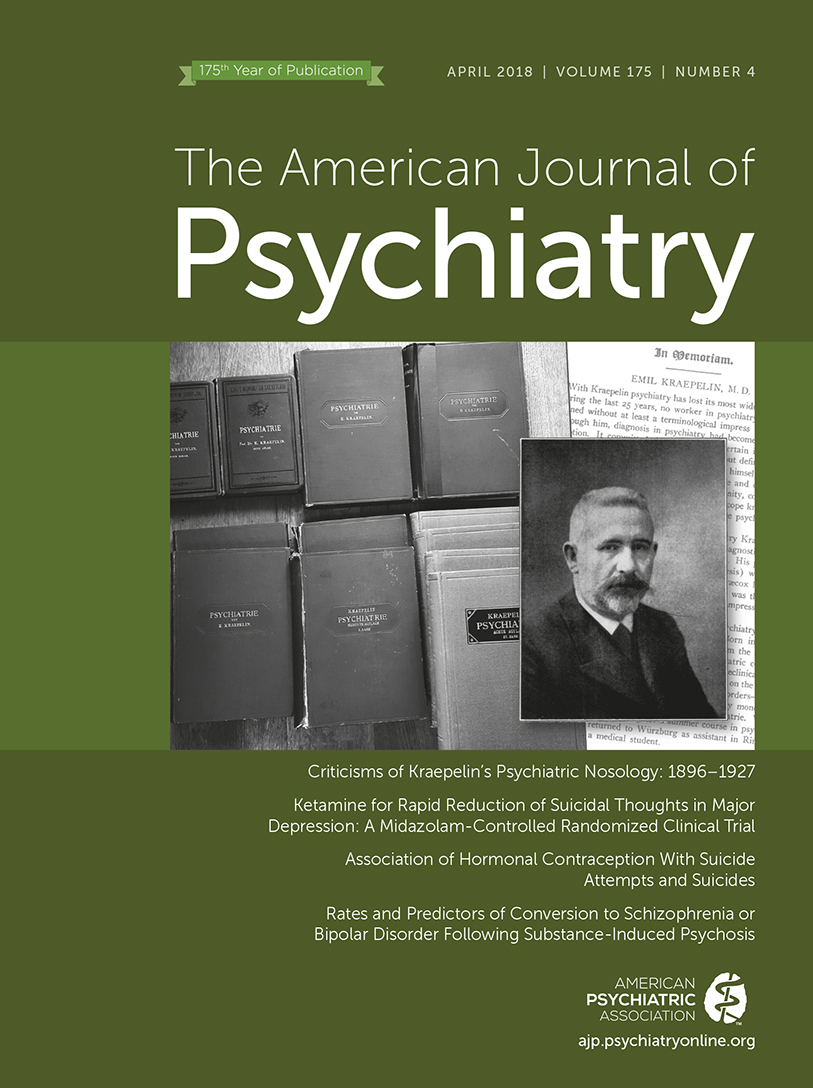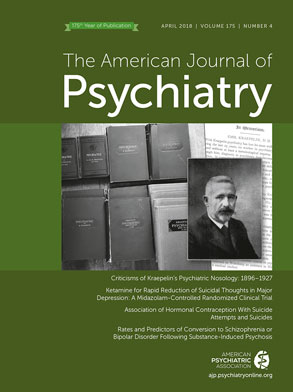Over 100 million women use hormonal contraception worldwide, and many health benefits have been documented (
1). Although a relationship between hormonal contraception and depression is known in clinical lore and is supported by some research, relatively little work has focused on suicidal outcomes. In this issue, Skovlund and colleagues (
2) provide an elegant and lucid report of their study finding that hormonal contraceptive use doubles the risk of suicide attempt and triples the risk of suicide.
The study used a nationwide registry to identify 475,802 women who were observed for an average of 8.3 years. Of this cohort, 54% were using hormonal contraceptives at some point during follow-up. Those with a previous history of antidepressant use or of a psychiatric disorder were excluded. The outcome measures were suicide attempt as recorded in the medical record and death by suicide. The authors found that the impact of hormonal contraceptive use on suicidal behavior was higher in adolescents compared with older women, that the incidence of suicidal behavior peaked 2 months after initiation of hormonal contraception, and that nonoral forms of hormonal contraception conferred the highest risks.
The strengths of this study are those typical of Scandinavian epidemiological samples: a large and representative sample, a long prospective follow-up, and careful methodology, censoring data during pregnancy, parsing the effects of current and past exposures to hormonal contraceptives, and reporting effects by type of hormonal contraceptive.
Among the study’s limitations is that we know very little about risk factors that may confound the relationship between hormonal contraceptive use and suicide attempt, such as past maltreatment, relationship discord, exposure to domestic violence, and family history of psychiatric disorders, all of which may predispose hormonal contraceptive users to suicidal behavior. This information may help identify who is likely to be vulnerable to these negative sequelae of hormonal contraceptive use. While the authors showed that the findings would be robust even in the face of one large confounding factor, there could be multiple confounders of smaller magnitude that may explain at least part of the reported relationship between hormonal contraceptive exposure and suicidal behavior. The method of selection of comparison groups may also have led to bias. A comparison of women using hormonal and nonhormonal forms of birth control may be a more valid one, particularly for adolescents, when earlier sexual debut and risky sexual behavior could be related to an increased risk for suicidal behavior. Finally, as in all registry studies, diagnostic data are based only on those who present for treatment.
The ways to evaluate the extent to which an observational study supports a causal relationship between exposure and outcome are that it successfully addresses confounders, demonstrates a temporal sequence between exposure and outcome, shows a dose-response effect, and produces findings that are biologically plausible.
While unmeasured confounders are a concern, at least two studies have shown that adolescent and adult women who use hormonal contraceptives are at
lower risk for depression compared with those using less effective forms of contraception. In one study of adolescents, those with
lower depressive symptoms were more likely to elect hormonal contraception rather than an intrauterine device (
3). In another study of sexually active women, those who used hormonal contraception were of higher socioeconomic status and had a more physically active lifestyle compared with women who used less effective or no contraception (
4). The Skovlund et al. study clearly demonstrated that hormonal contraceptive use preceded suicidal behavior, although past users continued to be at increased risk long after they stopped using hormonal contraceptives. Perhaps these individuals had a preexisting vulnerability to mood disorders unmasked by exposure to hormonal contraceptives.
With respect to dose-response effects, the risk of suicidal behavior tended to be higher in women who received 50 μg compared with those who received 20–40 μg of ethinyl estradiol, and higher in those who used progestins with androgenic properties.
The relationship between hormonal contraceptive exposure and suicidal behavior is plausible for several reasons. First, depression is a well-known precursor of suicidal behavior. This team has used a similar data set to demonstrate an increased risk of depression in women exposed to hormonal contraceptives, with similar patterns of risk (finding, for example, that adolescents are at higher risk than adults) (
5). Second, women at risk for postpartum depression were randomly assigned to receive either depot medroxyprogesterone acetate (DMPA) or an intrauterine device; those who received DMPA showed greater postnatal depression (
6). Neuroimaging studies have shown alterations in brain structure and function associated with hormonal contraceptive use, with thinning in the lateral orbital frontal cortex and posterior cingulate (
7), heightened insula and dorsal anterior cingulate cortex activation during the viewing of a traumatic film (
8), and alterations in resting-state connectivity (
9). However, in one elegant randomized study, women who had previously experienced affective symptoms while on hormonal contraceptives were studied in the follicular phase and then randomly assigned to receive either placebo or 30 μg of ethinyl estradiol/0.15 mg of levonorgestrel, and while alterations in connectivity were associated with hormonal contraceptive use, none of these alterations correlated with depressive symptoms (
10). Nevertheless, the general consensus is that both hormonal contraceptive use and menstrual cycle hormonal variations can have effects on systems that are also implicated in mood disorders (
11).
There are some dissenting voices, although divergent results may be explained by differences in sample selection and measurement. One longitudinal study of sexually active women 25–34 years old assessed use of hormonal contraceptives and self-reported depressive symptoms at several follow-ups and found that those using hormonal contraceptives had
lower levels of depression, and a
much lower risk of suicide attempt (odds ratio=0.37) than those using lower-efficacy contraception or no contraception (
4). In that study, the women using hormonal contraceptives had many characteristics that may be protective against depression, such as higher educational attainment and physical activity levels, but these findings persisted even after propensity adjustment. Since having unprotected sex is a health risk behavior associated with increased suicidal risk, it is possible that in that study, women who were using hormonal contraceptives were intrinsically less predisposed to suicidal behavior than those who were having unprotected sex.
What can be concluded from Skovlund and colleagues’ important and provocative study? First, there may be an association between hormonal contraceptive use and suicidal behavior, which is backed up by temporal sequence and possibly by biological plausibility. Second, adolescents may be more vulnerable to these effects. Third, those who have a past history of hormonal contraceptive use may continue to be at risk, perhaps because exposure to hormonal contraceptives unmasked a preexisting vulnerability to a mood disorder.
What is a clinician to do? Psychiatrists should routinely inquire about the use of hormonal contraceptives in their female patients and chart the temporal relationship of hormonal contraceptive use against depressive symptoms. Those prescribing hormonal contraceptives should continue to educate patients about the risk of mood symptoms and share this new information about risk for suicidal behavior. It is important for clinicians to convey to their patients that while this finding is concerning, it is a small effect and is not a definitive finding. Patients starting on a hormonal contraceptive should be monitored for depression and suicidal ideation, especially during the first 6 months after initiation.
With respect to research, while there is no consensus in the literature about the effects of menstrual cycle fluctuations and hormonal contraceptive exposure on brain structure and function, there is agreement that there are effects. It seems that we ought to start gathering information about luteal versus follicular phase status and hormonal contraceptive exposure in any studies that involve women and consider these factors as possible contributors to mood symptoms and suicidal risk. Unless we ask, we’ll never know for sure.
While the use of epidemiological principles and assessment of suicidal risk are part of my daily work, I was previously not familiar with the large literature on the effects of hormonal contraceptives and menstrual cycle fluctuations on brain structure and function. As a result of this study, I am going to pay a lot closer attention to these issues in my patients and in my research participants.

